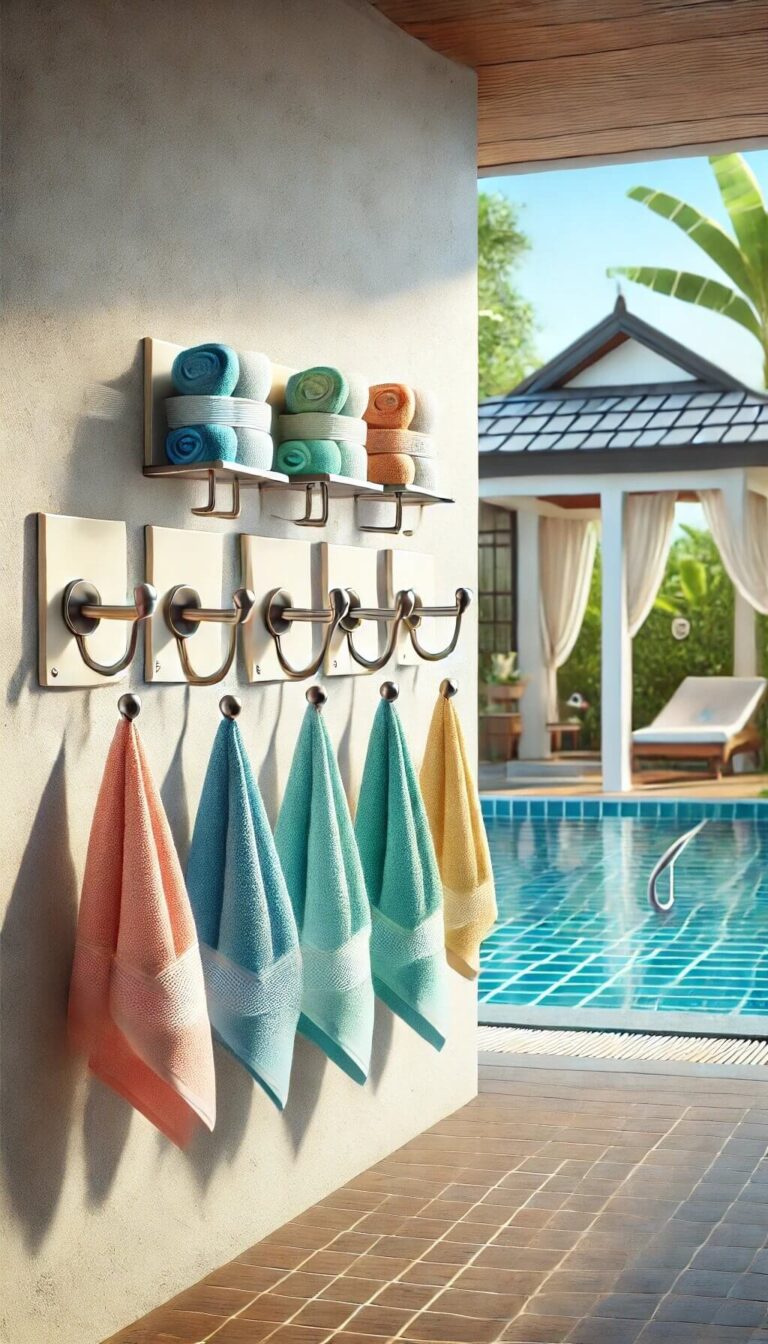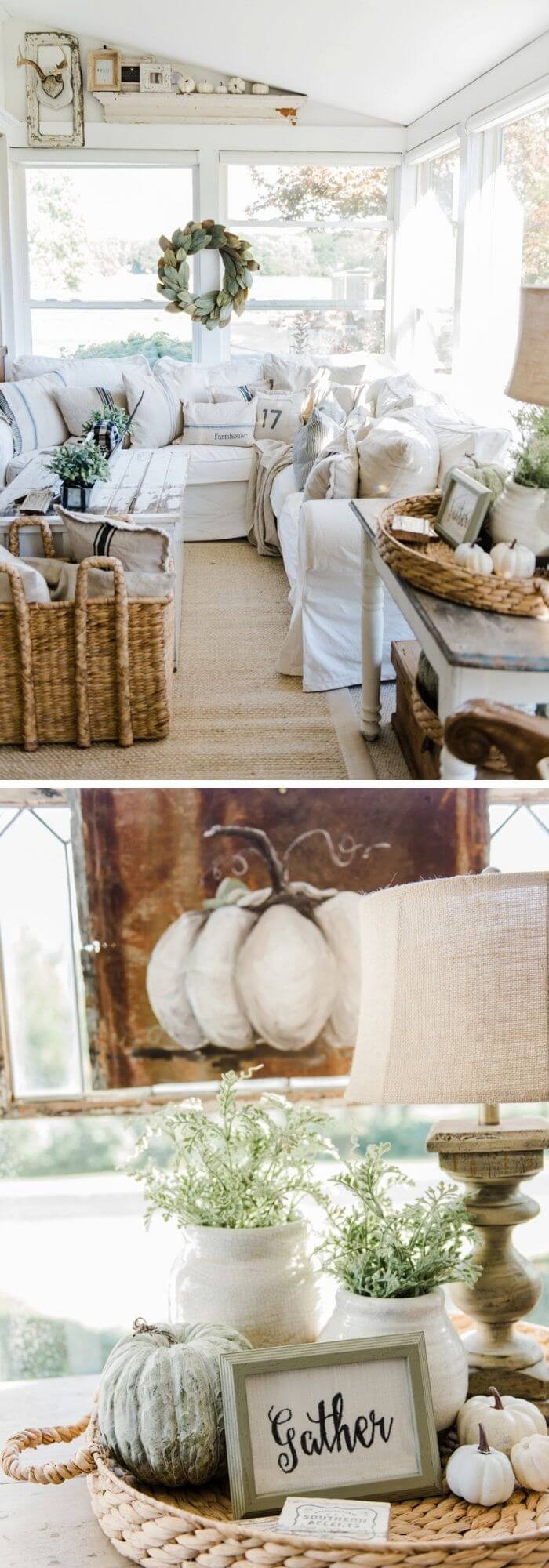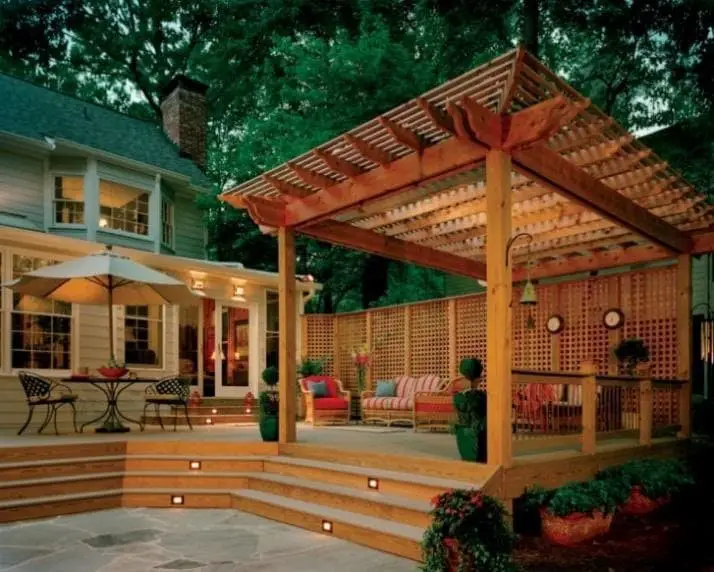18+ Best Landscaping Ideas With Mulch And Rocks
Mulch and rocks are two popular landscaping elements that offer numerous benefits. Not only are they cost-efficient, but they’re also low maintenance and can provide a natural look to any yard. For those who prioritize native landscaping or seek balance in their outdoor space, here’s where mulch and rocks can be particularly effective.
For instance, basalt rock mulch can add depth and texture to a backyard landscape, while rock and straw mulch can help level out uneven ground.
Native landscaping on a sloped yard can create a stunning visual effect, and succulent corner landscaping can bring a touch of elegance. By combining rocks with different textures and colors, you can achieve a unique design that showcases the best of both worlds.
Whether you’re looking for a cost-efficient solution to water puddling or seeking inspiration for a raised rock rain garden, mulch and rocks offer endless possibilities.
You can even create a cozy corner firepit or leave the grass out in certain areas to achieve a specific look. For those who want to replicate a cabin atmosphere, compact landscaping with mulch and rocks can be an excellent choice.
Ultimately, the key to successful landscaping with mulch and rocks is to experiment and find the right combination that works best for your outdoor space.
18 landscaping ideas with mulch and rocks
Basalt rock mulch on a backyard landscape
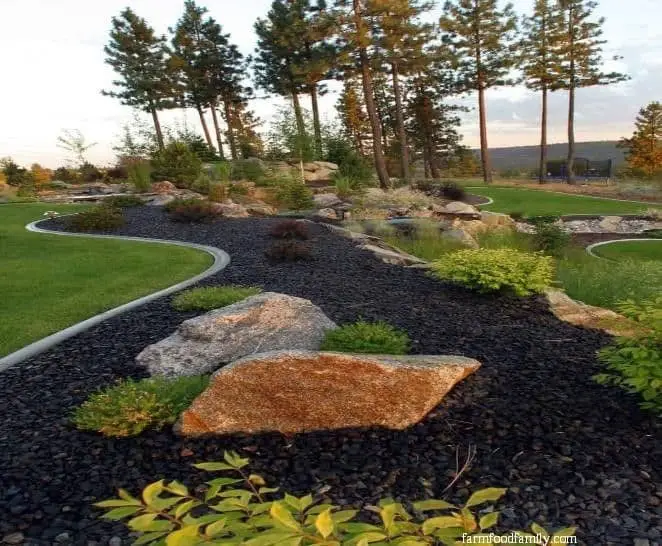
The elevated property’s unique design is further accentuated by the combination of basalt rock mulch and a decorative granite boulder. This striking visual contrast highlights the distinct landscaping features between the lower deck and the elevated space, creating an impressive edge landscape. The dark color of the rock mulch provides an added benefit, allowing the plants to take center stage and showcase their beauty.
Rock and straw mulch for an uneven ground
In areas with direct sunlight, this combination proves particularly effective in retaining moisture while creating an optical illusion of a uniform terrain. The straw mulch, with its ability to lock in hydration, takes on a darker hue that draws attention to the strategically placed rock boulders and lush vegetation scattered across the soil bed, highlighting their natural beauty.
Native landscaping for a sloped yard

When it comes to sloped yards, a harmonious combination of rocks and mulches is often the go-to choice. This design involves layering neutral-toned rocks and mulches in a tiered waterfall formation that flows into a small water pool. The remaining space can then be divided from the rest with vibrant grass turf.
Succulent corner landscaping
Incorporating a low-maintenance fence landscaping scheme into your outdoor space can be achieved by combining midwestern-inspired aesthetics with a gravel and stone spread for the soil bed. Rounding out this design is a rugged stone edging that defines the corner landscape. The arrangement is further enhanced by the addition of cacti and other desert plants, which add a touch of rustic charm to the overall ensemble.
Rock and mulch on two different sides
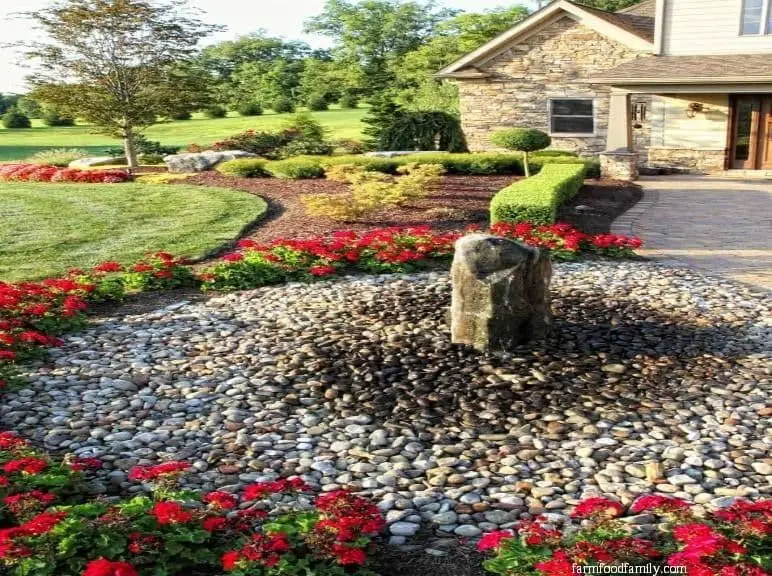
The relationship between these two landscaping elements is not necessarily permanent. In this design concept, the rocks are used as the foundation for a water fountain on one side, creating a visually appealing focal point. On the opposite side, the red pine mulch with hedging and subtle greenery provides a soft, contrasting element that harmonizes nicely with the surrounding turf grass.
Fieldstone and Hemlock mulch
A harmonious blend of traditional Japanese aesthetics and rustic charm emerges when combining classic Japanese gardens with a natural backdrop. The arrangement of fieldstones, showcasing varying colors and irregular patterns, serves as the pathway through this unique landscape. To achieve visual cohesion on a sloping yard, Hemlock mulch is employed as ground cover, presenting an appealing contrast not only to the fieldstones but also to the surrounding grassy areas.
Transitional backyard landscape
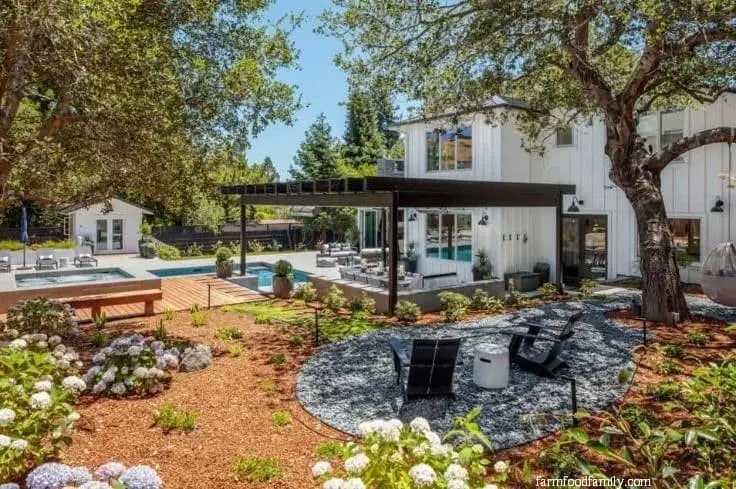
As you step out from the patio door, the transition to your backyard becomes seamless. A thoughtful touch is the use of river rocks as a natural ground cover for the seating area, which is beautifully framed by the shade of a large tree. The space is further enhanced by the addition of wood chip mulch, adding warmth and coziness to the entire landscape design.
Cost-efficient water puddling solution
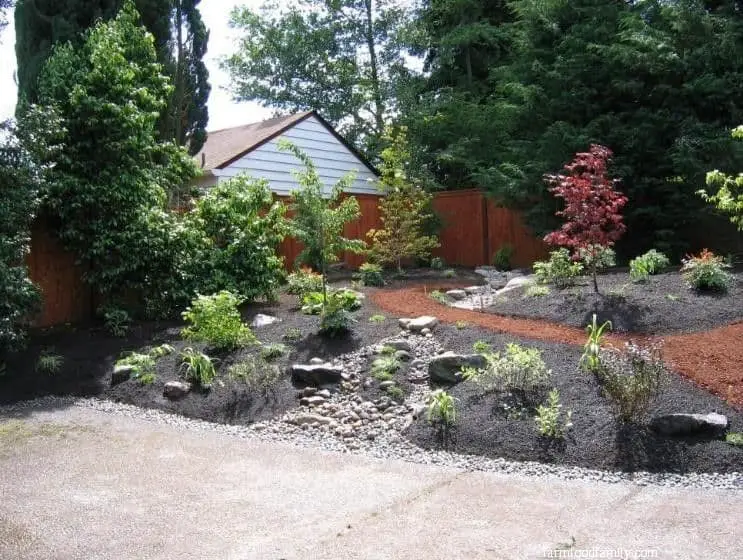
When it comes to tackling problematic sloped yards that consistently puddle water, especially during rainy seasons, a cost-effective solution lies in combining different mulching materials. A mixed mulch of wood chips and bark can prove to be an efficient choice for such areas. To take drainage efficiency to the next level, consider using cedar mulch along pathways. This will help absorb excess water and create a more effective flow.
For added visual interest and texture contrast, border the cedar mulch with a combination of bark and crushed gravel, along with some wood chip mulch. This unique blend can help mitigate the issues associated with water puddling on your sloped yard.
Raised rock rain garden
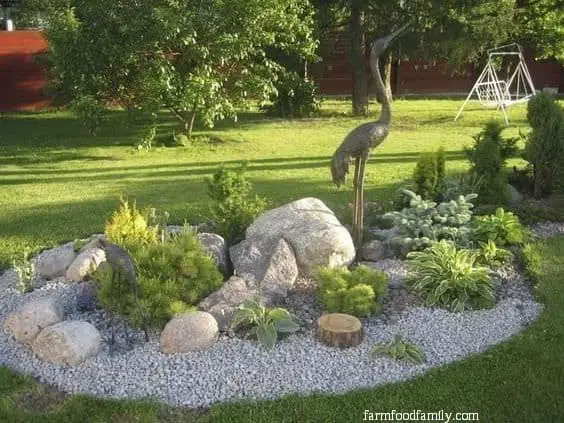
To add some visual interest to your landscape design, consider departing from the straightforward rain garden concept. Instead, incorporate a raised rock rain garden that combines river rocks with larger boulders and bigger rocks for added texture. This unique feature can be further enhanced by incorporating plants along the edges to create a soft, natural transition. The decorative elements will not only add depth but also provide a touch of elegance to the overall design.
Corner firepit
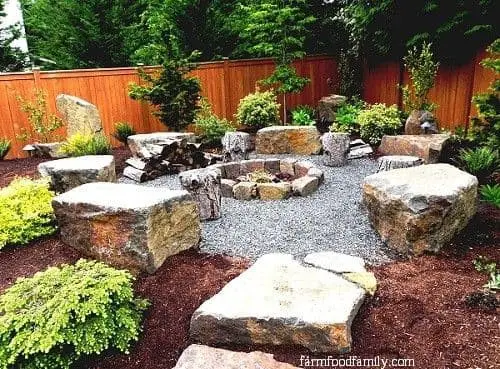
A sloped backyard presents an opportunity to create unique spaces that foster social interaction and relaxation. Rather than simply seeking to level the terrain, consider transforming the slope into a cozy gathering spot. One innovative way to do this is by installing a corner firepit, which becomes a natural hub for family and friends to congregate. The rustic charm of crushed gravel flooring provides a sturdy base for the space, while fieldstone seating adds a touch of natural elegance.
To create a sense of softness and comfort, cedar mulch has been used to line the walking path leading up to the fire pit, making it a inviting destination.
Leave the grass out
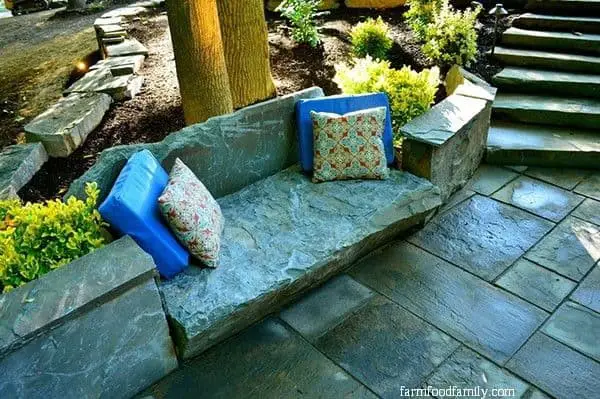
In certain areas of your garden, it’s not uncommon to find sections where grass growth is scarce or even nonexistent. Often, these blank spaces occur near mature trees, whose extensive root systems can outcompete smaller vegetation for water and nutrients. To create a visually appealing and low-maintenance space in these areas, consider transforming them into rock gardens.
This can be achieved by constructing raised planters using natural stone, which will not only provide a suitable environment for plants to thrive but also complement the surrounding trees’ grandeur. To add a touch of elegance, consider incorporating a stone bench, similar to the one pictured, which can serve as a peaceful retreat and encourage relaxation.
Cabin look
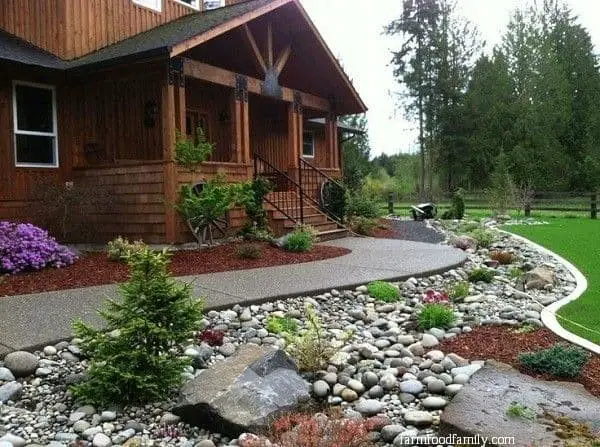
In regions where moisture prevails over sunlight, it’s essential to create visual contrast by separating rocks from mulch. At the cabin’s corners, wood chip mulch is strategically placed to complement the natural woody aesthetic of the structure. Conversely, along the paver walkway, a harmonious blend of river rocks and pea gravel is paired with naturally scattered plants to create a visually appealing arrangement.
Compact landscaping
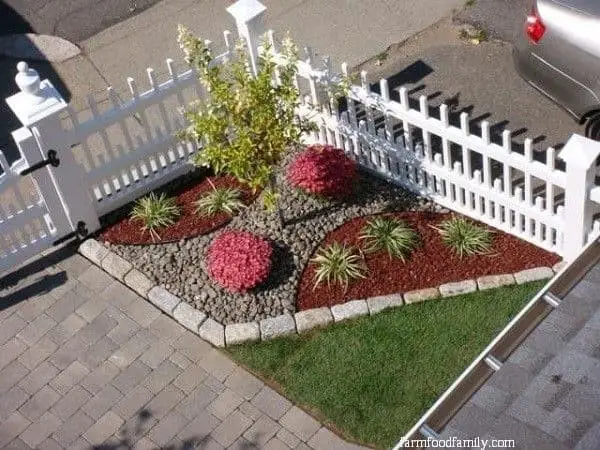
Townhouses may not have ample space for elaborate landscaping designs, but that shouldn’t limit your creativity. By incorporating medium-sized river rocks and mulch, you can still create visually appealing outdoor spaces. For instance, a compact landscaping scheme features a central arrangement of river rocks, which is flanked by two sides of carefully placed mulch to form a geometric pattern that optimizes the available space.
This design not only adds texture but also creates a sense of harmony in the landscape. Another compact design for the front yard utilizes river rocks as edging for a raised garden bed covered with mulch. To inject more visual interest, a twisted pattern of river rock edging is added at another end of the landscape, adding depth and dimension to the overall aesthetic.
Rock and mulch border
When designing a landscape featuring two-toned stone pavers, consider separating them to accentuate each tone’s unique character. One approach is to use a transitional border to create visual interest. For this method, combine wood chips for mulching the border and enclose it with white quartz rock, allowing the different textures and hues to harmonize.
Replacing turf grass with rocks
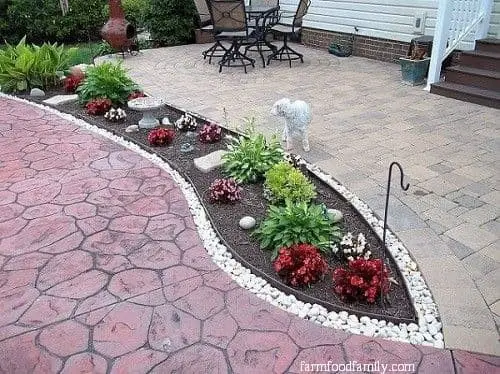
To create a low maintenance landscaping that’s both functional and aesthetically pleasing, consider replacing traditional turf grass with small rocks or pebbles. This can be achieved by spreading them evenly across your yard, effectively eliminating the need for constant mowing and watering. The raised decks leading to the patio door and backdoor provide a seamless transition from indoor to outdoor spaces, while the wooden steps on the pathway add a touch of natural elegance.
River rock planter
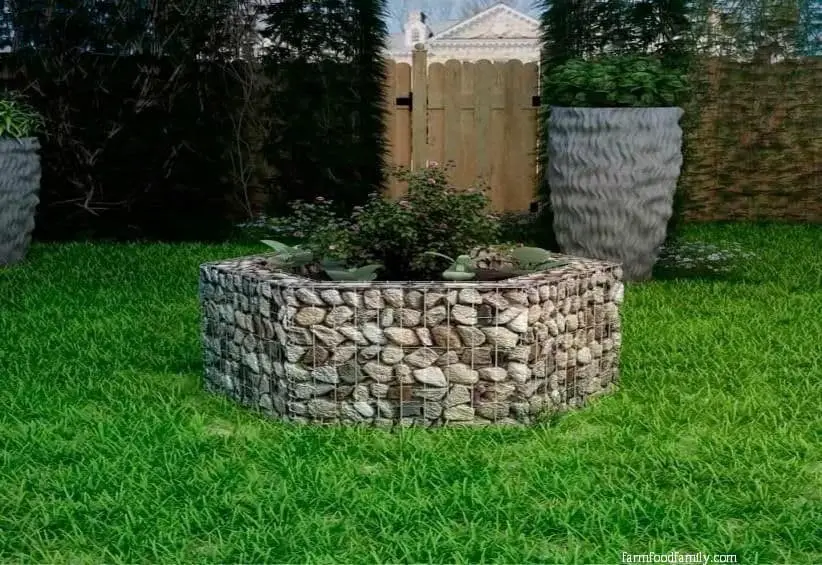
Instead of traditional mulching, consider creating unique planters using river rock to bring visual interest to your outdoor space. For instance, a galvanized steel frame can be used as the base and then filled with large river rocks. This unconventional planter can be topped off with an assortment of hardy plants, adding texture and depth to your landscaping design.
Zen rock garden
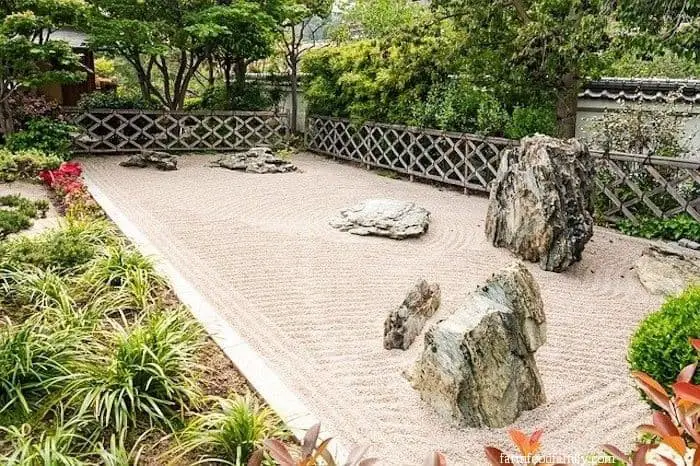
While traditional rock gardens often feature water elements, a zen-inspired courtyard can be just as serene without them. The focal point is a gravel-covered space, where crushed stone creates a soothing atmosphere. Strategically placed mossy boulders add visual interest and texture to the area. To create balance and harmony, the graveled expanse is flanked by mulch soil beds, home to lush shrubs and vibrant flowering plants.
Best of all worlds
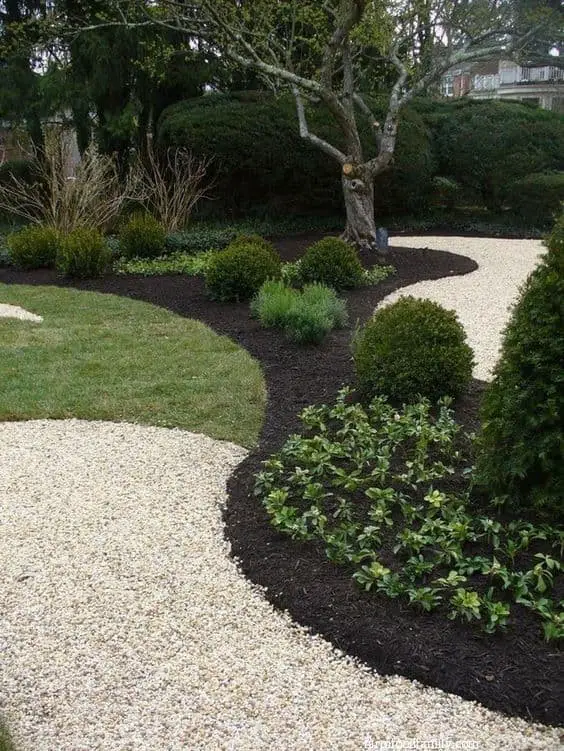
Achieving harmony in your outdoor space can be effortlessly achieved by combining different elements. In this design, a large tree serves as the centerpiece, with a unique twist: a winding path of black mulch radiates from the trunk to the center, creating visual interest. The area is then divided into four quadrants, where white river rocks and lush green turf are artfully arranged in an alternating pattern, adding depth and texture to the overall aesthetic.
FAQs
While considering the pros and cons of using mulch and rock in your landscaping endeavors, it’s essential to have a comprehensive understanding of their characteristics. To provide insight into the advantages and disadvantages of each option, as well as rough estimates of their costs, I’ve compiled a list of frequently asked questions that address key aspects of these popular landscaping materials.
Is mulch or rock better for landscaping?
When it comes to deciding between mulch and rock for landscaping, the debate can be quite intense. Instead of a simple yes or no, here’s a breakdown of the pros and cons of each option.
Mulch:
On one hand, mulch has several advantages. It’s often cheaper than rock and requires less maintenance. Mulch is also effective at keeping weeds at bay for longer periods, doesn’t burn, and resists wind damage.
Additionally, it’s perfect for gardens featuring rock and cacti, as it encourages plant growth, supplies more nutrients, and requires less water. Furthermore, mulch reduces soil compaction and erosion, stops weed growth, and can even benefit plants directly.
On the other hand, there are some potential drawbacks to consider. Mulch may not have a direct impact on plant health, and extremely high temperatures can mess with the pH level of the soil.
It also requires manual removal, which may lead to the introduction of weeds or encourage their growth. Furthermore, mulch needs annual replacement and may induce premature blooming in some plants.
Rock:
While rocks have their own set of pros and cons, they’re often used alongside mulch for one primary reason: weed suppression. Both options are employed in landscaping because of their shared ability to keep weeds from taking over the yard in a cost-efficient manner, no less.
What is the cheapest landscaping rock?
Crushed gravel, the most budget-friendly option, costs between $75 to $100 per ton. Bull rock and river rock follow suit, priced between $80 to $200 per ton. In contrast, landscape boulders are significantly pricier, ranging from $100 to $200 per ton. However, since you typically only need a small quantity of these larger rocks for landscaping purposes, your overall expenditure is likely to be much lower than the listed price.
How do you separate rock and mulch?
The most conventional method of separating rock from mulch is through the use of edging techniques. Specifically, turf edging and its variants that incorporate stone and concrete are among the most popular choices when it comes to creating a clear boundary between these two materials.
Conclusion
Beyond their cost-effectiveness, mulch and rocks prove to be valuable additions to any landscaping design, offering versatility, ease of maintenance, and a rich textural element that can elevate even the most basic outdoor spaces. Whether incorporated into a formal garden or used as a naturalizing force in a more casual landscape, these two elements are solid choices for any homeowner looking to create a beautiful and low-maintenance outdoor area.
Related Posts
When it comes to running a farm business, selecting the right equipment is crucial for efficiency and productivity. Similarly, homeowners need to prioritize installing a fence to safeguard their property. Meanwhile, there’s ongoing debate about tipping driveway sealers – understanding the etiquette surrounding gratuities can make all the difference. If you’re considering a career in landscape architecture or design, it’s essential to know what’s involved in becoming a certified professional.
Alternatively, if your passion lies in capturing the beauty of nature through photography, learning how to become a garden photographer can open up new creative possibilities.

